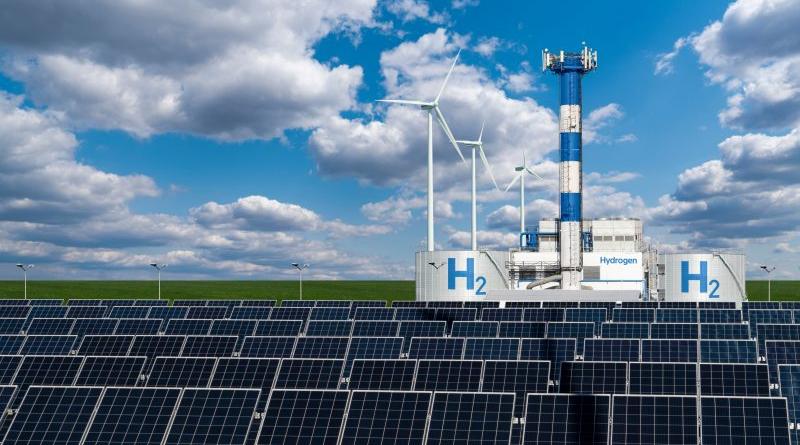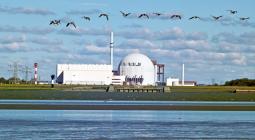It’s not just about the colour: too much hydrogen is unsustainable

The European Union’s oversized plans for renewable hydrogen are unrealistic and constitute a risk for the bloc’s public finances and decarbonisation efforts, write Luke Haywood and Cosimo Tansini.
Luke Haywood is policy manager for climate, and Cosimo Tansini is the policy officer for renewable energy at the European Environmental Bureau (EEB).
Renewable energy sources are surging. Solar and wind power displaced gas and coal to become the first source of electricity generation in the EU for the first time last year.
However, the fossil gas and nuclear lobbies have not stopped carving out plans to keep our economies tied to their businesses for the coming decades. Rather than squarely advocating for gas and nuclear, they have discovered a new strategy that fits into the net-zero momentum: advocating for massive “green” hydrogen plans.
Renewable hydrogen (or “green”) is produced through electrolysis using renewable electricity. While debates on hydrogen sustainability largely focus on its colour, the dangers go beyond this.
Even if green, large-scale hydrogen production requires massive investments and risks driving significant amounts of renewable electricity away from solutions that could decarbonise faster and cheaper. Slowing this transition will give extra lifespan to fossil fuel and nuclear power.
Europe’s oversized plans
The EU hydrogen targets – 20 million tonnes, including domestic production and imports by 2030 – are more than twice what is optimal for a transition to a 100% renewables-based energy system, according to the Paris Agreement-compatible (PAC) energy model developed by European Environmental Bureau and CAN Europe.
The trajectory of technological uptake required to meet such targets outstrips the historical growth not only of wind and solar power: in fact, hardly any other technology has ever experienced such rapid growth.
While the ability of the hydrogen industry to deliver the required growth is doubtful, alternatives are ready. Direct electrification, coupled with increased energy efficiency in buildings, industrial processes and transport modes, can decarbonise our energy systems without the risk of relying on unproven hydrogen production capacities.
The financial strain
The needed surge of electrolysis capacity will require immense private and public investments and risk weighing heavily on EU and national financial resources.
BloombergNEF estimates investment costs of €24 to €42 billion by 2030 to meet the EU’s targets for domestic production. Even the lower end of that estimate exceeds the total amount of grants available under the recent RePowerEU package, intended to support the roll-out of renewables, energy efficiency, and more (20 billion euros).
Increasing the share of hydrogen in the gas grid to 20% would lead to prices rising by up to one-third for final consumers. Using hydrogen as opposed to more efficient direct electrification implies higher bills.
The most recent evidence suggests the cost disadvantage of hydrogen compared to fossil gas persists even if carbon prices rise to four times current levels and despite projected hydrogen cost reductions. Will EU governments and citizens accept the associated further increases in energy prices?
Battle for renewables
Producing large volumes of green hydrogen will require a lot of new solar and wind generation — and much more than with a strategy focusing on direct electrification and energy efficiency.
This is problematic: the EU’s own projections for new renewable capacity show that renewables remain insufficient to decarbonise the power sector fully, cover newly emerging electricity demand, and produce the desired volumes of renewable hydrogen by 2030.
More renewables dedicated to hydrogen production will also tend to raise prices for other renewable production, given the stiff competition for resources to produce solar panels and wind turbines: human resources, land, and materials. It is extremely difficult to ensure that hydrogen production does not make it more challenging for renewables to decarbonise our energy system more broadly.
Hydrogen production will only bring climate benefits if it is strictly based on additional renewable electricity. How to ensure that is currently the subject of heated discussions at the EU level. Industrial groups and their political allies are pushing EU policymakers to relax the rules on renewable hydrogen.
It makes sense that the industry is calling for less stringent requirements: with truly strict criteria in place, producing large volumes of renewable hydrogen will remain challenging in the next decade.
A sustainable strategy for hydrogen, therefore, depends both on how it is manufactured and on the scale at which it is produced.
The way forward
The size of future hydrogen production is critical. Europe should not bet its path to decarbonisation on a technology that has not proved its potential to sustainably produce at scale.
Heavily subsidising hydrogen for the sake of industrial competitiveness will translate into subtracting much-needed financial resources from other crucial investments to deliver renewables, energy efficiency, and energy security.
In turn, targeted investments towards more limited production targets and uses will allow us to make the best use of both energy and financial resources.
Besides rescaling production targets downwards, credibly making long-term commitments to the strictest additionality requirements for renewable hydrogen is equally crucial.
Without additionality, hydrogen production will cannibalise renewables meant to decarbonise other parts of the economy, hamper climate mitigation, and put public support for the transition at risk.
cover photo:Even if green, large-scale hydrogen production requires massive investments and risks driving significant amounts of renewable electricity away from solutions that could decarbonise faster and cheaper. Slowing this transition will give extra lifespan to fossil fuel and nuclear power. [Shutterstock / Scharfsinn]





